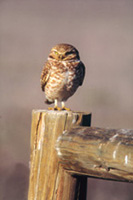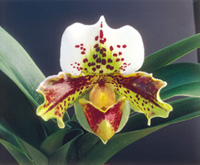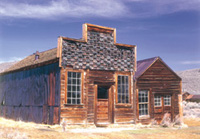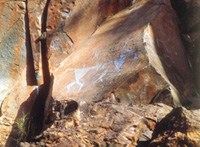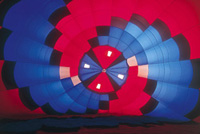Format Selection
Bigger Is Better, Or Is It
Big Sky Country, The Big Muddy, Big Bad John, and, of course, The Big Kahuna All expressions of the ultimate, best, or baddest thing around. As anyone who has taken even the most rudimentary photography class can tell you, the highest quality comes from the film with the most real estate. Bigger film is always a guarantee of better quality. Or, put another way, there's nothing wrong with 35mm that a 4x5 won't fix. I'd like to suggest that perhaps we shouldn't be too dogmatic about the bigger is better business. Let's compare the most common film formats and see if we can put some new light on some of the tenets we've come to accept. Standard Formats, Lots
Of Choices Medium format, cameras accepting 120 or 220 roll film, can be confusing, as there are a number of formats offered that use the same film size. The most common of these are: 6x4.5cm, 6x6cm, 6x7cm, and 6x9cm. For the panorama enthusiast 6x12cm and 6x17cm formats are available as well. Although not as readily available as it used to be, you can even find sheet film in medium format (6x9cm). Even the smallest of the medium formats, 6x4.5cm, is considerably larger than 35mm and requires much less enlargement for a given print size. Large format refers to cameras that take sheet film measuring 4x5" all the way up to 20x24". Most of these cameras can also be adapted to utilize medium format roll film. |
|||
Film Format And Enlargeability OK, 35mm requires much great-er enlargement to make an 8x10 print than 4x5. So let's all sell our 35mm stuff and start shooting 4x5, is that what you're saying Dickerson? Well, sorta. If the only consideration was enlargeability, detail, and grain we'd all shoot 4x5. But there's more, much more, that we need to consider. Accepted Tenets Aren't Always
True |
|||
First, does 4x5 really make better images than 35mm? Of course it does€most of the time. If you were to shoot a scenic with your 35mm on a solid tripod, using a slow film, with a good quality fixed focal length lens under ideal conditions and then take the same image with a 4x5 outfit with the same conditions, the larger format will beat the 35mm every time, hands down. The 35mm image will be good, and with today's lenses and film it will be damn good, but it won't compete with the 4x5 image. Up to about 11x14 the two images will be remarkably similar but with greater enlargement the 4x5 image begins to have a real advantage. But what if the conditions aren't ideal. What if it's windy? Take a good look at a 4x5 view camera. Looks a lot like a box kite doesn't it? It doesn't take much wind to reduce the 4x5 advantage to almost nil. On really windy days I'll automatically opt for my 35mm kit because I know the 4x5 will be too hard to work with. I'll spend more time waiting for the wind to die down than I will setting up shots, and that's counterproductive. With the 35mm I still have to be careful of wind motion but it's much less of an issue with the smaller camera's diminutive profile. Advantage: 35mm. |
|||
Are they as sharp as fixed focal length lenses? Probably not. But today's zoom lenses are so good that the difference is negligible, unless of course you're trying to compare 35mm images with 4x5 images. Ah, now here we have catch 22. As we all know, you can't compare apples and oranges. But, as photographers, we try to do it all the time. So what's the real definitive answer? Well, I'll tell you, it definitely depends. Match The Tool To The Task As you may have guessed, 35mm equipment has many obvious advantages, plus some frequently overlooked bonuses. Let's talk turkey for a moment. Bird photographers frequently work with lenses in the 400-600mm range, focal lengths that are readily available for 35mm cameras. A 400mm lens gives an 8x magnification compared to a standard 50mm lens. To achieve the same magnification with a medium format camera requires a lens in the 600-840mm range, not readily available and very expensive. If you shoot 4x5, it's even more daunting as you'd need a 1200mm optic to realize the same 8x magnification. |
|||
Large format is almost impossible to use for moving subjects, another area where 35mm and medium format really shine. Do you shoot macro? Well, medium format and 35mm offer many accessories: extension tubes, extension bellows, macro lenses, etc., to facilitate close-up work. Plus the smaller cameras handle more easily in the tight quarters often encountered shooting macro. To fill the frame with a single poppy using 35mm you'll be shooting somewhere around a 1/4x to 1/2x magnification. To fill a 4x5 negative with the same flower you'll need to enlarge it 2x to 3x, requiring an incredible amount of bellows extension. This increases the wind problem and camera shake, not to mention reducing the depth of field to almost nothing. I hope you're beginning to see that the format question is not merely one of film size compared to print size, but a more complex issue that requires careful consideration. For many pros, medium format is a compromise that offers many of the virtues of 35mm with the added advantage of the larger film size. Others prefer 4x5, or larger formats, but shift to medium format or 35mm when conditions, subject matter, or the assignment dictates. |
|||
Another important factor is portability and weight. Working a few yards from the car almost any camera will suffice, but on a multi-day backpack or paddling trip size and weight become critical. Larger cameras also require bulkier and heavier tripods, yet another concern. So, choose your format and camera type intelligently. Don't be influenced solely by what others are using. Sure, listen to the advice of those whose work you admire. Talk to the consistent winners at the camera club competitions. But, ultimately, you should choose the format and system that is going to give you the results you're after and allow you to work in a way that you will find enjoyable and productive. Good shooting. |
